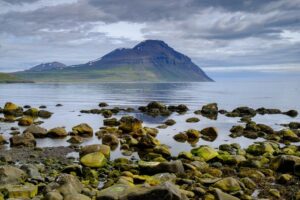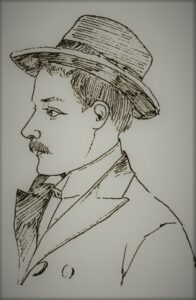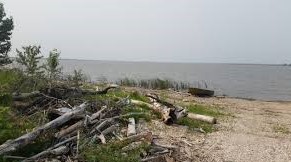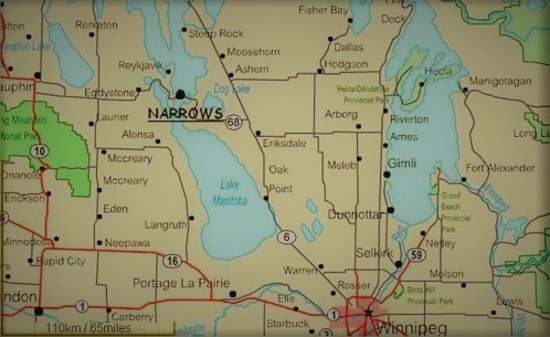Jón Jónsson from Sleðbrjót wrote a chapter in Ólafur Þorgeirsson’s Almanak in Winnipeg about Icelandic settlements north of Lake Manitoba. In 1914 there was an article by him about Siglunes, Narrows, Dog Lake and Moose Horn Bay. This chapter he mostly based on conversations with settlers or their short reports. One of those who wrote to Jón was Sigurður Baldvinsson from Gunnólfsvík in N. Múlasýsla. Jón thought Sigurður’s letter was good, so he published it in its entirety. Jón wrote about this: “Sigurður Baldvinsson lives northwest of the Narrows. From him I have received a genealogy and a summary of his life, which I put here verbatim, because it describes people better than I can do with my words:”
Origins

Gunnólfsvíkurfjall
“I moved to the West in 1902, when I was 25 years old, from Gunnólfsvík in Norður Múlasýsla. My father is Baldvin Guðmundsson, Sigvaldason, Eiríksson, Styrbjörnsson, a farmer at Ketilsstaðir in Jökulsárhlíð in N. Múlasýsla. That land was occupied by the poor (Kristfjárjörð). Once a whale washed ashore there, and Styrbjörn shared it with the residents in this rural community for free. Soon after, another whale washed ashore, and Styrbjörn took it in the same way. But when the magistrate heard about the transactions, he rode to Styrbjörn’s home and demanded to be involved in the proceedings and said that Styrbjörn’s treatment of the whale was not legal. Styrbjörn reacted angrily, picked up put an iron stick and threatened the magistrate, and said that he would shorten his life, unless he promised never to claim the whale, because God had sent it to the poor, and the magistrate saw fit to comply.” -(Here comes an interjection from Jón: “Between brackets it should be mentioned that the person who is writing this has heard that Styrbjörn had a keg full of liquor (brennivín) in his shed and the story has it he and the magistrate sat down after they made their peace and emptied the keg”) “My father’s mother was Soffía Sigurðardóttir from Skógar in Axarfjörður; she was the paternal sister of archdeacon Sigurður Gunnarsson in Hallormsstaðir, and the descendants are said to be from farmer Jón in Mýlaugsstaðir in Reykjadal in Þingeyjarsýsla; Jón was the father of Reverend Ingjaldur in Múla and Reverend Þórarinn, who was a long-time priest in Skagafjörður and was the father of the “Bólstaðarhlíðar sisters (Bólstaðarhlíðarsystra)”. One of the daughters of Jón of Mýlaugsstaðir was the mother of Þórður, the sheriff of Sandhólar at Tjörnes in Þingeyjarsýsla.”
Family – Western home

This drawing of Sigurður accompanied Jón’s article in Almanak. Artist – stranger.

Here is a view of Lake Manitoba from Hjartareyja.
“I married in 1898 María Björnsdóttir Þorleifsson, a merchant at Bíldudal in Arnarfjörður. Björn’s mother was Ingibjörg, sister of Gróa, the wife of Ólaf, a farmer at Sveinsstaðir, brother of Reverend Halldór at Hofi in Vopnafjörður. But my wife’s mother was Anna Bergsteinsdóttir, originally from Keflavík in Gullbringusýsla. My wife has turned out to be both a worthy and beautiful woman. We have many children and are prosperous, we came to this settlement poor and then I took land in Hjartareyja (Red Deer Island) north of the Narrows and I have felt comfortable there; I now have 300 sheep and 30 cattle. For the first 3 years after I came here, I stayed in the town of Gladstone, Manitoba, doing various “temporary” jobs. There I often had contests with various townspeople who rarely got the better of me. I must have sometimes gone “around” the local laws and often got into trouble with the police; I sometimes used the Viking method of my ancestor Styrbjörn; but most of the time the police officers treated me well. I moved to this village in 1906. I have written this to you so frankly to show how the family traits remain in the male line century after century. We have good health and stamina, so I don’t think there will be much regression in the family. My Viking nature does not coincide with the way of the modern age. I have named my sons Björn and Kári. I would like to go home to Iceland and rebuild my ancestor Styrbjörn’s land, but I lack the money and education to do that.”
Jón ends the article with: “I have little to add to Sigurður’s review. He is intelligent and knowledgeable and reads everything he can about Iceland. Forms his own opinions and holds firm on them. He is considered to have the strength of two men and nearly equally matched between strength and persistence.”

